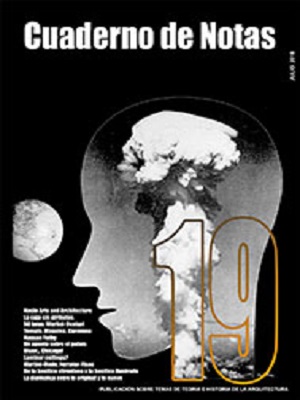El discurso arquitectónico de Hassan Fathy Lo vernáculo desde una perspectiva moderna
DOI:
https://doi.org/10.20868/cn.2018.3817Palabras clave:
Hassan Fathy, arquitectura, construcción, tradición, planificación, architecture, construction, tradition, planningResumen
Resumen
La condición de arquitectura alternativa apunta a procesos individualistas alejados de convencionalismos de contexto. La internacionalización de los postulados modernos condujo a la crítica a eludir en sus análisis construcciones de revitalización de una arquitectura considerada como excesivamente identitaria. Este artículo analiza el esfuerzo del arquitecto egipcio Hassan Fathy (1900-1989) por reivindicar, a todas las escalas, la sabiduría de la edificación tradicional durante un periodo coincidente con la modernidad occidental. La escasez de hierro y cemento en Egipto, tras la II Guerra Mundial, fomentó la recuperación de una construcción de bajo coste adaptada a las circunstancias y recursos materiales del lugar. La durabilidad de la arquitectura popular que permanecía conservada desde tiempos remotos, y sobre todo su eficacia en el control climático, fomentó en Fathy el deseo de aprendizaje de métodos y dispositivos tradicionales tanto constructivos como espaciales que fueron reinterpretados con una lectura moderna, desde el ámbito doméstico al urbano, en la morfología y materialización de sus proyectos.
Abstract
The “alternative” architectural condition points to individualistic processes that give results far removed from the conventionalisms of context. The internationalization of the modern postulates led the critique to leave constructive procedures in the analyses of revitalization of an architecture considered as excessively identitarian, to one side. This article analyses the effort of the Egyptian architect Hassan Fathy (1900-1989) to defend at all levels, during a period coinciding with Western modernity, the wisdom of traditional inherited edification. The scarcity of iron and cement in Egypt, after the Second World War, boosted the recovery of a low-cost construction adapted to the climatic conditions and the material resources available locally. Popular architecture’s durability, especially its utilitarian aspect, preservedsince ancient times and, in particular, its effectiveness in climate control, inspired in Fathy the desire to learn traditional constructive and spatial devices. The questioning of the figure of the “Muallim”, or Master Mason, which had become a source of inherited knowledge, with regards vernacular constructive systems, added to his own analysis of popular architecture, gave him a knowledge of autochthonous materials and passive mechanisms of environmental control that were reinterpreted with a modern reading in the materialization of both his domestic and urban projects.
Descargas
Referencias
El-Wakil, Leila. 2013. Hassan Fathy dans son temps. Gollion: Infolio Editions.
El-Shorbagy, Abdel-moniem M. 2001. The architecture of Hassan Fathy: between western and non-western perspectives [en línea]. Tesis Doctoral. University of Canterbury. [consulta 03-07-2017]. Disponible en https://ir.canterbury.ac.nz/handle/10092/7557.
Fathy, Hassan. La voute dans l’architecture egyptienne, [en línea], La reveu de Caire nº140, mayo 1951, pp.14-20 [consulta 07-07-2017], Hassan Fathy Archives. Aga Khan Trust for Culture. Geneva, Switzerland. Disponible en https://archnet.org/authorities/1/publications/6462.
Fathy, H. The Ekistical Approach To The Problem of Roofing in Farming Houses, 25 Nov de 1963, [en línea], Hassan Fathy Archives. Aga Khan Trust for Culture. Geneva, Switzerland Working Paper nº 2/8, p.3, [consulta 07-07-2017]. Disponible en https://archnet.org/system/publications/contents/6444/original/DPC3203.pdf?1384797388.
Fathy, H. 1973. Architecture for the Poor: An Experiment in Rural Egypt. Chicago: University Chicago Press.
Fathy, H. 1978. Toward an Architecture in The Spirit of Islam [en línea]. Philadelphia: Editorial Renata Holod [consulta: 2-07-2017]. Disponible en https://archnet.org/collections/57/publications/3495.
Fathy, H. 1986. Natural Energy and Vernacular Architecture. Principles and Examples with References to Hot Arids Climates. Chicago: University of Chicago Press.
Fampton, Kenneth. 1999. Estudios sobre cultura tectónica. Poéticas de la Construcción en la Arquitectura de los siglos XIX y XX. Madrid: Ed. Akal S.A.
Fampton, K. Entrevista realizada por Anatxu Zabalbeascoa [en línea] en Confidencias. Visionarios. El País Semanal 10 de marzo 2017 [consulta: 2-07-2017]. Disponible en http://elpaissemanal.elpais.com/confidencias/kenneth-frampton/.
González Fraile, Eduardo M. Arquitectura, construcción y climatización sostenible. “El badgir” [en línea], Libro de Actas del XI Congreso Internacional de Construcción con Tierra, Tradición e Innovación (XI CIATTI 2014). Celebrado en Valladolid y Cuenca de Campos desde el 26 al 29 de septiembre de 2014. ISBN: 978-84-606-9543-1. Editado por E.T.S. de Arquitectura de Valladolid. Julio 2015 [consulta 07-07-2017]. Disponible en Http://www5.uva.es/grupotierra/publicaciones/digital/libro2015/010gonzalez.pdf.
Guitart, Miguel. 2014. Utopía y fracaso en la arquitectura vernácula africana: Hassan Fathy en Nueva Gourna, en Ensayos sobre Arquitectura y Cerámica. Libro de Actas de III Congreso de Cerámica y Arquitectura, celebrado en ETSAM, Madrid desde 28 a 29 de Abril de 2014. ISBN:978-8492641505. Editado por Cátedra Cerámica, pp 72-84.
Taragan, Hana. Architecture in fact and fiction: the case of the new Gourna Village. Recogido en PARAMITA, Kristanti Dewi. Culture Based Architecture: Recognising the Difference. ARC, [en Línea], 2009, vol. 6988, p. 3. Disponible en http://www.maad.postgrad.shef.ac.uk/files/arc-6988-design-methodologies-essaaaaayyy.pdf.
Rudofsky, Bernard. 1976. Arquitectura sin arquitectos. Breve introducción a la arquitectura sin genealogías. Buenos Aires: Editorial Universitaria.
Steele, James. 1988. Hassan Fathy. London: Academy Editions/St Martin’s Press.
Steele, J. 1989. The Hassan Fathy Collection. A catalogue of Visual Documents at The Aga Khan Award of Architecture. [en línea] The Aga Khan Trust for Culture, [consulta 05-07-2017], ISBN: 2882070039, Disponible en https://archnet.org/system/publications/contents/3528/original/DPC0304.pdf?1384775505.
Steele, J. 2002 Orientalism and the other: the Case of Hassan Fathy [en línea]. Dissertation, University of Southern California Digital Library, [consulta 21-01-2018]. Disponible en Http://digitallibrary.usc.edu/cdm/ref/collection/p15799coll16/id/233031.
Steele, J. 2007. An Architecture for People: The Complete Works of Hassan Fathy. London: Thames and Hudson.













